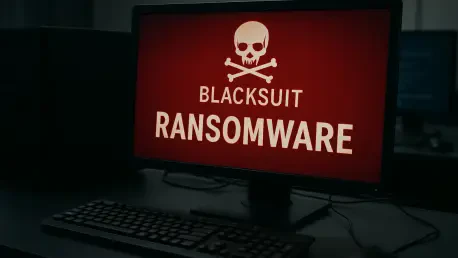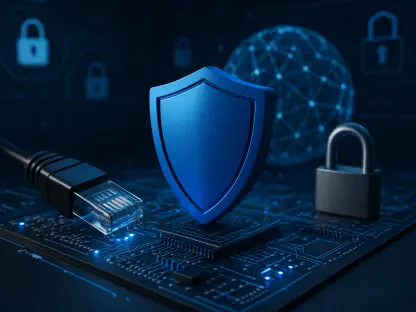Imagine a digital predator lurking in the shadows of the internet, striking at the heart of critical infrastructure—hospitals, energy grids, and government systems—holding them hostage for millions in ransom. This is the reality of BlackSuit ransomware, a Russia-linked cybercrime group that has wreaked havoc across the United States and beyond, extorting an estimated $370 million from over 450 US victims. As ransomware threats continue to escalate, global law enforcement has mounted a fierce counterattack, most notably through Operation Checkmate. This roundup dives into diverse perspectives from cybersecurity experts, industry leaders, and law enforcement officials to unpack how this international effort disrupted BlackSuit, the challenges that persist, and the strategies needed to combat an ever-evolving cyber menace.
Unveiling BlackSuit: Perspectives on a Cyber Menace
BlackSuit ransomware has emerged as a formidable adversary, targeting high-value sectors with ruthless precision. Cybersecurity analysts describe the group as a master of “big-game hunting,” focusing on organizations where downtime can cause catastrophic consequences, such as healthcare and energy. Their double extortion tactics—encrypting data and threatening to leak sensitive information—have amplified the pressure on victims to pay up, often in the millions.
Industry observers highlight the staggering scale of BlackSuit’s impact, with high-profile cases like Octapharma, a plasma collection organization forced to shutter nearly 200 centers temporarily, illustrating the real-world fallout. The consensus among experts is that the group’s Russia-linked origins complicate enforcement efforts, as geopolitical barriers often shield perpetrators from prosecution. This backdrop of impunity has fueled urgency in the global response to such threats.
A recurring theme in discussions is the broader implication of BlackSuit’s operations for national security. Many in the field argue that ransomware is no longer just a financial crime but a direct assault on societal stability. This perspective underscores why initiatives like Operation Checkmate are seen as critical, not just for immediate disruption but for setting a precedent in international cooperation against cybercrime.
Operation Checkmate: Diverse Views on a Coordinated Takedown
Breaking Down BlackSuit’s Digital Stronghold
Operation Checkmate, launched on July 24, represents a landmark effort in the fight against ransomware, with US agencies like the FBI and Homeland Security Investigations joining forces with partners in the UK, Germany, and several other nations. Law enforcement representatives emphasize the operation’s tangible successes, including the seizure of four servers, nine domains, and over $1.09 million in cryptocurrency, alongside the shutdown of BlackSuit’s dark web leak site. This collaborative strike is hailed as a model for future interventions.
However, some cybersecurity professionals caution that while infrastructure takedowns are impactful, they are not a silver bullet. The absence of arrests during the operation raises questions about long-term deterrence. Many note that identifying and apprehending individuals behind such groups remains a daunting task due to jurisdictional hurdles and the anonymity afforded by digital tools.
A third viewpoint comes from international policy analysts who stress the importance of data captured during the operation, particularly by German authorities. They argue that this information could be pivotal in unmasking key figures within BlackSuit. Yet, skepticism lingers about whether such leads will translate into actionable outcomes given the reluctance of certain countries to extradite cybercriminals.
Targeting the Big Players: Opinions on Double Extortion
BlackSuit’s strategy of targeting critical sectors has drawn sharp criticism from industry stakeholders, who describe the approach as particularly insidious. Cases like CDK Global, a car software company reportedly forced to pay a $25 million ransom, highlight how these attacks disrupt essential services and economies at large. Experts in crisis management point out that the ripple effects often extend far beyond the immediate victim.
The use of double extortion tactics is another focal point of concern among cybersecurity specialists. By encrypting data and threatening leaks, BlackSuit maximizes leverage over its targets, a method that many believe will only grow more prevalent. Some industry leaders advocate for stricter regulations on ransom payments, arguing that compliance fuels the cycle of crime.
Contrasting opinions emerge on how organizations should respond to such threats. While some consultants recommend robust backup systems to mitigate encryption risks, others warn that leaked data can still cause irreparable reputational harm. This divide in thought underscores the complexity of defending against a multifaceted attack strategy that exploits both technical and psychological vulnerabilities.
Adapting to Change: BlackSuit’s Rebranding as Chaos
Recent analyses by security researchers point to BlackSuit’s likely rebranding as Chaos ransomware, active since early this year with 20 new victims already listed on a dark web site. This adaptability is a major concern for many in the cybersecurity community, who describe ransomware groups as shape-shifters capable of evading even the most sophisticated takedowns. The speed of this pivot raises alarms about the resilience of such criminal networks.
Regional differences in response to this evolving threat are also a topic of debate. Experts note that while Western nations have ramped up collaboration, gaps in extradition agreements with certain countries create safe havens for cybercriminals. Some policy advisors call for stronger diplomatic efforts to close these loopholes, though they acknowledge the political challenges involved.
A more pessimistic outlook comes from veteran analysts who question the long-term efficacy of operations like Checkmate. They argue that infrastructure disruptions, while impactful, often fail to address the root networks of talent and funding that sustain these groups. This perspective challenges the notion that technological solutions alone can outpace the ingenuity of determined adversaries.
Future Threats: Broader Concerns in Ransomware Evolution
Beyond BlackSuit, the ransomware landscape is seen as increasingly collaborative, with some observers warning of alliances among notorious gangs that could amplify their destructive potential. Insights from former negotiators suggest that future threats might escalate beyond financial extortion to include physical harm, a chilling prospect that adds urgency to current prevention efforts. Such warnings paint a grim picture of what lies ahead.
Speculation on emerging attack methods also dominates discussions, with many anticipating more sophisticated exploits leveraging artificial intelligence or other advanced technologies. Cybersecurity strategists stress the need for proactive international policies to keep pace with these innovations, advocating for frameworks that prioritize rapid information sharing across borders.
A balanced view comes from those who see Operation Checkmate as a stepping stone, not a solution. They argue that while the operation achieved significant short-term wins, the adaptive nature of groups like BlackSuit—or Chaos—demands a fundamental rethink of defense mechanisms. This includes fostering public-private partnerships to pool resources and expertise against a common enemy.
Lessons Learned: Collective Takeaways from the Crackdown
Feedback from various sectors points to Operation Checkmate as a powerful example of what global collaboration can achieve, with the disruption of BlackSuit’s infrastructure marking a significant blow to its operations. Law enforcement officials and cybersecurity firms alike emphasize that such unified efforts are essential to countering threats that transcend national boundaries. The operation’s outcomes are often cited as proof of concept for multinational task forces.
For organizations, practical advice abounds on fortifying defenses against ransomware. Many experts recommend investing in comprehensive cybersecurity training to combat phishing, a common entry point for attacks, alongside adopting zero-trust security models that assume no user or device is inherently safe. These measures are seen as critical first steps in building resilience.
Additional insights focus on preparedness, with incident response plans being a key recommendation from industry consultants. Engaging with law enforcement before and after an attack is also advised, as it can provide access to resources and intelligence that individual entities might lack. This collective wisdom underscores a shift toward proactive, rather than reactive, cybersecurity postures.
Reflecting on the Fight Against Ransomware
Looking back, the collaborative triumph of Operation Checkmate stood as a testament to what global unity could accomplish against a pervasive digital threat like BlackSuit ransomware. The operation’s success in dismantling key infrastructure and seizing assets offered a momentary reprieve, while diverse expert opinions illuminated both the victories and the persistent challenges of this ongoing struggle.
Moving forward, actionable steps emerged as vital considerations for all stakeholders. Governments were encouraged to strengthen international agreements on cybercrime prosecution, closing gaps that allow perpetrators to operate with impunity. Businesses needed to prioritize cybersecurity investments, integrating advanced threat detection and employee training into their core operations. For individuals and smaller entities, staying informed about phishing tactics and maintaining secure backups became non-negotiable practices. These combined efforts, built on the lessons of past operations, paved the way for a more resilient defense against the relentless evolution of ransomware threats.









